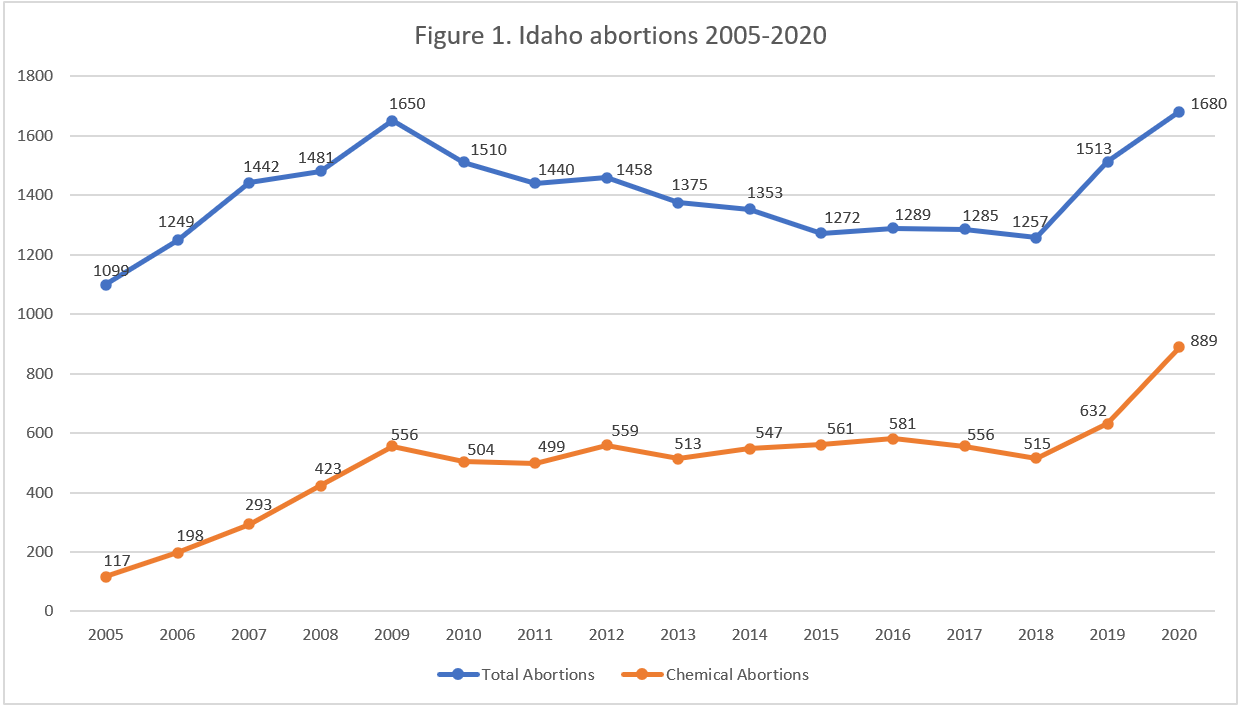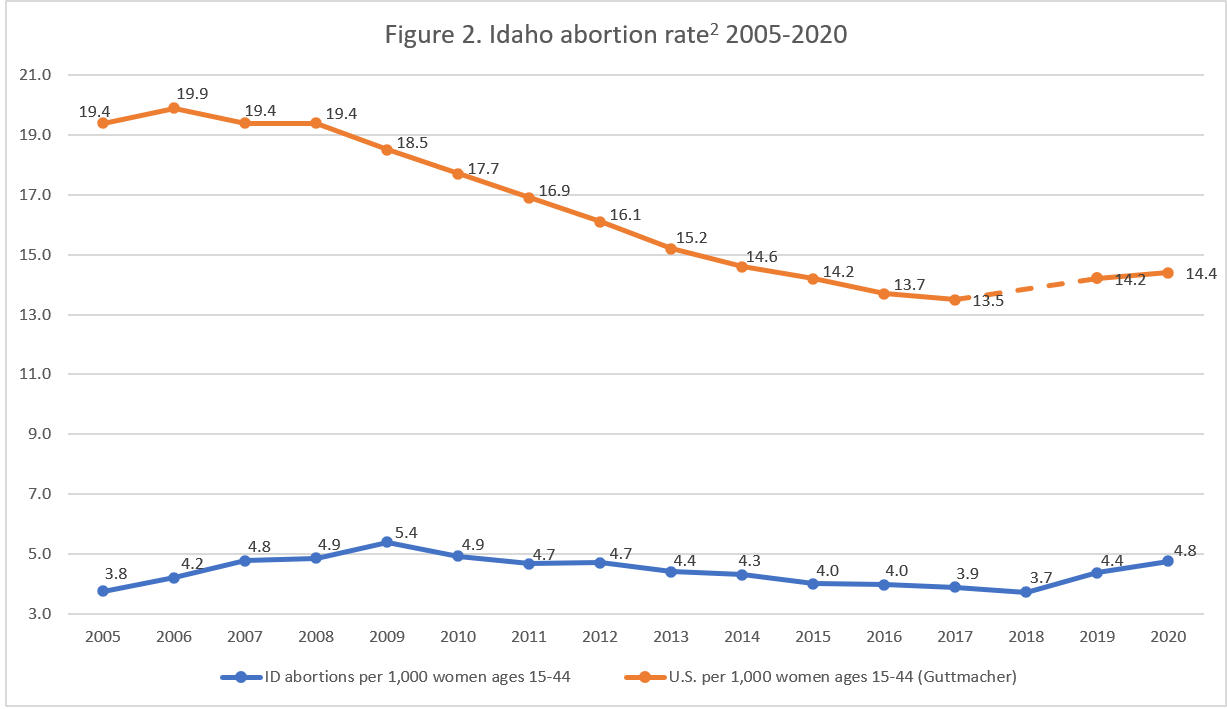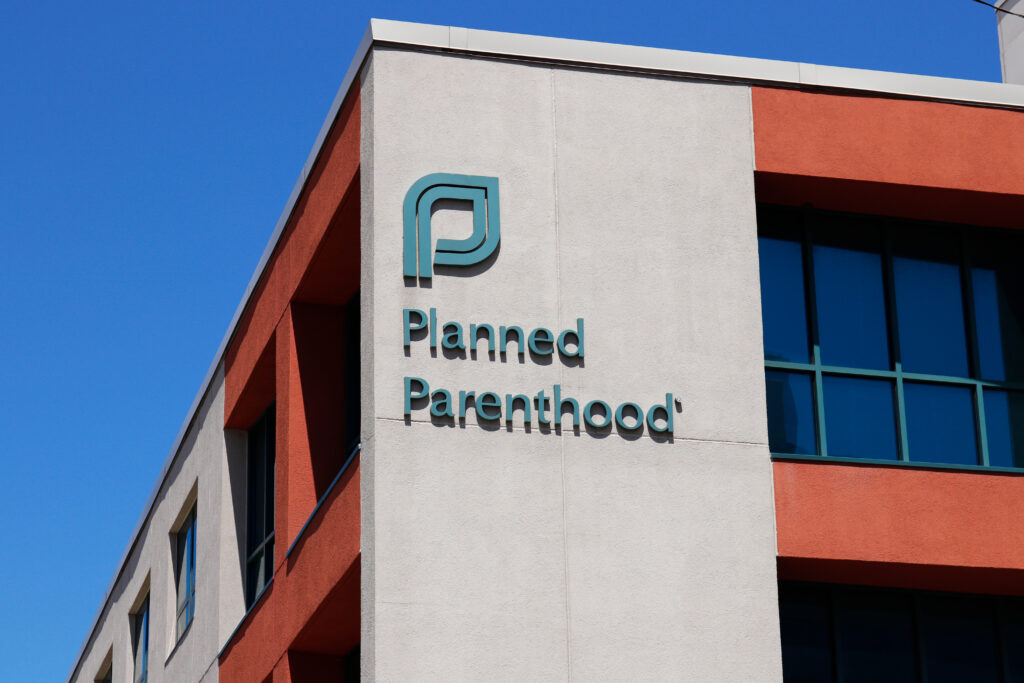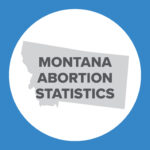Abortion Reporting: Idaho (2020)
Idaho’s 2020 abortion report was published by the Idaho Department of Health and Welfare in January 2022. The report shows that abortions increased from the previous year.
Statistics and Changes in Idaho Abortions: 2019-2020

The report does not include information on Planned Parenthood’s Idaho abortion market share.
Abortion Totals and Trends
Idaho reported that 1,680 abortions were performed in the state in 2020, an increase of 11 percent from 2019 (Fig. 1). Chemical abortions jumped by 41 percent to 889 abortions in 2020, 53 percent of the state total. The Charlotte Lozier Institute (CLI) estimates that Idaho’s abortion rate increased nine percent to 4.8 abortions per 1,000 women ages 15-44, although it was still lower than the national rate (Fig. 2). As of September 2022, 35 states had released 2020 abortion statistics, with 22 states showing that abortions had increased.
Idaho separately reports the number of abortions performed on state residents, whether they occurred in Idaho or in other states. Idaho resident abortions increased six percent (Fig. 1). Similar to the previous year, the increase in abortions on Idaho residents was among women who obtained their abortions in Idaho. The number of Idaho women who went out-of-state for abortions actually declined slightly in 2020 (433 abortions, down from 463 in 2019).
State Report Summary
Abortions Occurring in Idaho
Ninety-four percent of Idaho abortions were performed on state residents, while six percent were obtained by nonresidents or women of unknown residence.
Twelve percent of Idaho abortions were performed on girls under the age of 19, including three percent on girls under the age of 18. A third were on women ages 20 to 24, and a quarter were obtained by women ages 25 to 29. Twenty-seven percent were performed on women in their thirties, and three percent were conducted on women ages 40 and older.
The majority of the abortions reported in Idaho, 86 percent, were obtained by white women. Not quite three percent were performed on black women, with another three percent on Asian or Pacific Islander women. One percent each were on American Indian women and women of other races. Race was not reported for six percent of the abortions. Three-quarters of the abortions were on non-Hispanic women, compared to 22 percent on Hispanic women and three percent on women of unknown ethnicity.
Seventy-five percent of Idaho abortions were performed on unmarried women. Twenty-one percent were on married women, a higher percentage than in many other states, and four percent were on women of unknown marital status. Eighty percent of the abortions were obtained by women who reported no previous abortions. Fifteen percent were on women with one prior abortion, and five percent were on women with two or more prior abortions. Just over half the abortions were performed on women with no prior live births, while 19 percent were on women with one birth and 30 percent on women with two or more births.
Sixty-nine percent of the abortions were performed earlier than nine weeks of gestation. Fifteen percent occurred between nine and 10 weeks, and six percent were reported between 11 and 12 weeks. Seven percent of the abortions were performed early in the second trimester between 13 and 15 weeks of gestation. One percent were performed between 16 and 20 weeks, and 0.2 percent (four abortions) were reported between 21 and 24 weeks of gestation. Zero abortions were reported after 25 weeks of gestation, while gestational age was not reported for five abortions.
Chemical abortions made up over half of all Idaho abortions in 2020. Forty-two percent were conducted using suction curettage, and five percent were performed via dilation and evacuation. There were two sharp curettage abortions and two intrauterine instillation abortions. There was one abortion performed via some other means and another abortion for which the type of procedure was not reported.
As required by law, women were provided with educational materials in advance of 99 percent of the abortions. For three abortions, it was not reported whether educational materials were provided. Idaho’s report explains that “It is possible to have reports of procedures with unknown or no patient educational materials provided in rare cases of medical emergencies.”
Fifty-three abortions were performed on minors under the age of 18. In 49 cases, a parent or guardian provided consent for the abortion. In one instance, the minor was emancipated and provided consent for herself, and in two cases minors gave consent after a court order enabled them to do so. There was one abortion on a minor for which the type of consent was not reported. Idaho’s report explains that the state is following up with the abortion provider for more information.
There were 39 reports of abortion complications in 2020, up from 21 in 2019.1 Multiple complications could be reported for each abortion. Twenty-six of the complication reports were for chemical abortions, while 11 were for suction curettage procedures and one was for a dilation and evacuation abortion. One complication report was filed for an abortion of unknown method. There were 32 incomplete abortions and three failed abortions in which the pregnancy was ongoing. There were four cases of hemorrhage and one cervical injury. One psychological or emotional condition was reported, as was one instance in which pain or cramps did not improve with medication. An additional unspecified complication was reported. In two cases, the woman was sent to the emergency room or urgent care.
Eighty-two percent of the abortions occurred in Ada County, while 17 percent were performed in Twin Falls County. Not quite one percent were performed in Valley County.
Residence
Separately, Idaho reports abortions on state residents, whether the abortion occurred in Idaho or in a different state. However, not all states share abortion data with Idaho, so these statistics are incomplete. In 2020, there were 2,007 abortions known to have been performed on Idaho residents. Seventy-eight percent of these were performed in Idaho (1,574 abortions), while 22 percent were performed in other states (433 abortions). Eighteen percent occurred in Washington and two percent were performed in Utah. Montana and Oregon accounted for 0.7 percent each, while one abortion was performed in another unspecified state.
Twelve percent of Idaho resident abortions were performed on girls under the age of 20. Thirty-two percent were obtained by women ages 20 to 24, and a quarter were on women ages 25 to 29. Twenty-seven percent of the abortions were on women in their thirties, and three percent were on women ages 40 and older.
White women obtained the majority of the abortions (86 percent). Two percent each were performed on black women and Asian and Pacific Islander women, while not quite two percent were on American Indian women. One percent of the abortions were obtained by women of other races. Seven percent were performed on women whose race was not reported.
Seventy percent of the abortions were performed before nine weeks of gestation. Fourteen percent were performed between nine and 10 weeks. Six percent of the abortions performed on Idaho residents were reported between 11 and 12 weeks of gestation, and seven percent occurred between 13 and 15 weeks. Two percent were performed between 16 and 20 weeks. One percent of the abortions occurred at 21 weeks of gestation or later, with 17 abortions (0.8 percent) between 21 and 24 weeks and four abortions (0.2 percent) at 25 weeks of gestation or later. Gestational age was not reported for five abortions.
Fifty-five percent of the abortions obtained by Idaho residents were chemical abortions, and 39 percent were suction curettage procedures. Six percent were conducted using dilation and evacuation. There were two sharp curettage abortions, one intrauterine instillation abortion, and one abortion performed using some other method. The type of procedure was not reported for one abortion.
Heartbeat Law
In April 2021, Idaho enacted a law to limit abortion when the unborn baby’s heartbeat can be detected, approximately six weeks of gestation. The law was modeled after Texas’ heartbeat law and gives the unborn baby’s family the right to sue the abortion provider. The law was slated to go into effect 30 days after a court upheld another heartbeat law, but was temporarily blocked by the Idaho Supreme Court after a challenge from Planned Parenthood. After the Supreme Court decided Dobbs v. Jackson Women’s Health Organization, giving states the ability to pass laws limiting abortion, Idaho’s heartbeat law was allowed to go into effect.
State Ranking
In CLI’s 2016 analysis of abortion reporting across the country, Idaho was ranked at 17th best. Idaho could improve its reporting by listing the states of residence of nonresident women who travel to Idaho for abortions, as CLI has previously recommended. Idaho could also periodically remind providers of the abortion complication reporting requirement and survey hospitals and emergency rooms to ensure all complications are reported, similar to the way in which the neighboring state of Wyoming confirms abortion statistics.


- Statistics on abortion complications reported here represent a minimal number of complications, as this data is collected in a non-systematic and non-verifiable way. As such, this data cannot be used to calculate either an accurate abortion mortality rate or an accurate abortion complication rate for the state.
- Rates were calculated by CLI using the following formula: (total number of abortions performed in Idaho ÷ number of resident women ages 15-44) x 1,000. Rates may differ slightly from previous CLI articles due to revised population estimates. Population estimates were obtained from CDC WONDER.
Click here to view reporting from:2023202220212019201820172016























